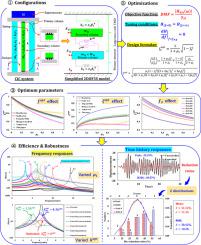当前位置:
X-MOL 学术
›
Int. J. Mech. Sci.
›
论文详情
Our official English website, www.x-mol.net, welcomes your feedback! (Note: you will need to create a separate account there.)
Optimization of column-in-column system based on non-conventional TMD concept
International Journal of Mechanical Sciences ( IF 7.1 ) Pub Date : 2024-06-22 , DOI: 10.1016/j.ijmecsci.2024.109497 Xiaojun Fang , Hong Hao , Kaiming Bi , Jian Song , Yongsheng Cao , Zhangyan Chen
International Journal of Mechanical Sciences ( IF 7.1 ) Pub Date : 2024-06-22 , DOI: 10.1016/j.ijmecsci.2024.109497 Xiaojun Fang , Hong Hao , Kaiming Bi , Jian Song , Yongsheng Cao , Zhangyan Chen

|
Previous studies showed that the non-conventional tuned mass damper (TMD) with large mass ratio outperforms the traditional one in respect to the structural vibration control efficiency and robustness. The authors recently proposed a novel control system based on the non-conventional TMD concept, namely the column-in-column (CIC) system, which was composed of a primary column, a secondary column and a series of interconnected springs/dashpots. In this novel system, the secondary column connected to the primary one with springs/dashpots could act as a large TMD to attenuate adverse vibration of the primary structure, and its control effectiveness was preliminarily verified through numerical investigations. However, the control robustness was found not sufficient based on the existing optimal formulae in the literature for CIC optimization. This paper presents a new design method for optimizing the CIC system for better harnessing its control effectiveness and robustness in reducing structural response. The CIC system consists of two columns with distributed mass and uniform flexural rigidity, connected by springs along the column height. The effective modal mass and modal stiffness of a specific vibration mode of the system can be straightforwardly calculated by using the Euler-Bernoulli beam theory. Considering the fundamental vibration mode of the system as the target response mode for vibration control, the multiple degree-of-freedom (DOF) CIC is simplified into a two DOF with three springs (2DOF3S) structural model, the design parameters, i.e., the optimal tuning frequency ratio and damping ratio of this system are derived to minimize the displacement response of the primary structure. To demonstrate the proposed design method, the effectiveness and robustness of the CIC system in controlling seismic induced structural vibrations are assessed in both the frequency and time domains. Results show that the derived optimum formulae are applicable for optimizing the TMD system with consideration of the distributed mass and deformation of the mass damper, i.e., a column in this study. The optimized CIC system has good control robustness even if the CIC is mistuned with its design parameters deviate from the optimal values by ±50 %. The conventional TMD system with lumped mass as the mass damper is a special case of the proposed CIC system. The optimized CIC system has favorable control efficiency in mitigating the seismic responses of structures with reduction ratios averagely varying within the range of 15 % ∼ 55 % with a probability of 92.67 %. It is concluded that the proposed method is reliable and can be used for the optimum design and control of the CIC system.
中文翻译:

基于非传统TMD概念的塔中塔系统优化
先前的研究表明,大质量比的非传统调谐质量阻尼器(TMD)在结构振动控制效率和鲁棒性方面优于传统阻尼器。作者最近提出了一种基于非传统TMD概念的新型控制系统,即柱中柱(CIC)系统,该系统由主柱、副柱和一系列互连的弹簧/缓冲器组成。在这一新颖的系统中,通过弹簧/缓冲器连接到主柱的副柱可以充当大型TMD来衰减主结构的不利振动,并且通过数值研究初步验证了其控制有效性。然而,根据文献中现有的CIC优化最优公式,发现控制鲁棒性不够。本文提出了一种优化 CIC 系统的新设计方法,以更好地利用其控制有效性和鲁棒性来减少结构响应。 CIC 系统由两根质量分布且抗弯刚度均匀的立柱组成,通过弹簧沿立柱高度连接。利用欧拉-伯努利梁理论可以直接计算系统特定振动模式的有效模态质量和模态刚度。考虑系统的基本振动模式作为振动控制的目标响应模式,将多自由度(DOF)CIC简化为三弹簧二自由度(2DOF3S)结构模型,设计参数,即推导了该系统的最佳调谐频率比和阻尼比,以最小化主体结构的位移响应。 为了证明所提出的设计方法,CIC 系统在控制地震引起的结构振动方面的有效性和鲁棒性在频域和时域进行了评估。结果表明,推导的最佳公式适用于考虑质量阻尼器(即本研究中的柱)的分布质量和变形的 TMD 系统优化。优化后的CIC系统即使在CIC失调、设计参数偏离最优值±50%的情况下也具有良好的控制鲁棒性。以集总质量作为质量阻尼器的传统 TMD 系统是所提出的 CIC 系统的特例。优化后的CIC系统对减轻结构地震反应具有良好的控制效率,减缩率平均在15%~55%范围内变化,概率为92.67%。结果表明,该方法可靠,可用于CIC系统的优化设计和控制。
更新日期:2024-06-22
中文翻译:

基于非传统TMD概念的塔中塔系统优化
先前的研究表明,大质量比的非传统调谐质量阻尼器(TMD)在结构振动控制效率和鲁棒性方面优于传统阻尼器。作者最近提出了一种基于非传统TMD概念的新型控制系统,即柱中柱(CIC)系统,该系统由主柱、副柱和一系列互连的弹簧/缓冲器组成。在这一新颖的系统中,通过弹簧/缓冲器连接到主柱的副柱可以充当大型TMD来衰减主结构的不利振动,并且通过数值研究初步验证了其控制有效性。然而,根据文献中现有的CIC优化最优公式,发现控制鲁棒性不够。本文提出了一种优化 CIC 系统的新设计方法,以更好地利用其控制有效性和鲁棒性来减少结构响应。 CIC 系统由两根质量分布且抗弯刚度均匀的立柱组成,通过弹簧沿立柱高度连接。利用欧拉-伯努利梁理论可以直接计算系统特定振动模式的有效模态质量和模态刚度。考虑系统的基本振动模式作为振动控制的目标响应模式,将多自由度(DOF)CIC简化为三弹簧二自由度(2DOF3S)结构模型,设计参数,即推导了该系统的最佳调谐频率比和阻尼比,以最小化主体结构的位移响应。 为了证明所提出的设计方法,CIC 系统在控制地震引起的结构振动方面的有效性和鲁棒性在频域和时域进行了评估。结果表明,推导的最佳公式适用于考虑质量阻尼器(即本研究中的柱)的分布质量和变形的 TMD 系统优化。优化后的CIC系统即使在CIC失调、设计参数偏离最优值±50%的情况下也具有良好的控制鲁棒性。以集总质量作为质量阻尼器的传统 TMD 系统是所提出的 CIC 系统的特例。优化后的CIC系统对减轻结构地震反应具有良好的控制效率,减缩率平均在15%~55%范围内变化,概率为92.67%。结果表明,该方法可靠,可用于CIC系统的优化设计和控制。












































 京公网安备 11010802027423号
京公网安备 11010802027423号